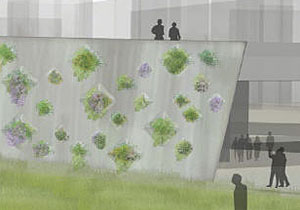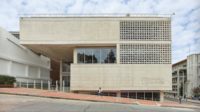Since its completion in 1997, the Guggenheim Museum Bilbao has been a splendidly sore thumb in the cityscape. While its main entrance aligns with the center-city artery Parraguirre, the Frank Gehry–designed icon undulates and vibrates on the shore of the city’s namesake river, ostensibly alone: Only a bridge and some austere landscaping butt up against the architecture.



Images © Balmori and Bilbao Ria 2000
Balmori Associates won a design competition last week with its proposal for Campa de los Ingleses, a 6.2-acre park that will abut Frank Gehry’s Guggenheim Museum in Bilbao, Spain. The site features a 32.8-foot grade change, which Balmori have accommodated with ramps and terraces. These terrace walls will include a tapas bar, restrooms, and plantings; RTN Architects collaborated with Balmori on these elements.
This jewel is poised to receive a more fitting setting. Balmori Associates, a landscape and urban design firm based in New York City, won a competition last week to design the park Campa de los Ingleses. It will be situated next to the Guggenheim, extending south and west toward the Deusto Bridge. The green space is the final component of the Abandoibarra redevelopment district master plan, which Balmori designed with Pelli Clarke Pelli Architects—then called Cesar Pelli & Associates—and Aguinaga & Associates a decade ago.
The 6.2-acre parcel features a 32.8-foot grade change. To make the Abandoibarra suitable for pedestrian movement between the Guggenheim and future landmarks including university and library buildings designed by Álvaro Siza and Rafael Moneo, Balmori conceived meandering paths that create curving terraces linked via ramps and stairs. “The main concept for the park was to tie together the Abandoibarra,” says Balmori associate and landscape design director Mark Thomann. “Imagine a graceful line tracing paths from the Guggenheim’s curves and running through the site to each of the buildings and up to the Plaza [Euskadi] and city, as well as down through the riverside and bridges.”
Thomann says terracing the site was “the solution to allow more level ground for areas to sit, gather, picnic, and play Frisbee. The sculpting also allowed a much richer topography from which to experience different views of the park, Abandoibarra, the mountains, river, and city.”
Although not specifically called for by the competition brief, the design inserts the terrace walls with services such as a tapas bar and public restrooms, on which Balmori collaborated with the Argentinean firm RTN Architects. These auxiliary structures’ eye-like shapes seem informed both by Gehry’s building and the new landscape’s sweeping gestures. Paving, benches, and walls will interpret traditional patterns found in Spanish tiles.
Aside from easing the relationships between once and future works of Bilbao architecture, the Campa de los Ingleses will also disguise one existing structure. A raked wall filled with plants will be erected immediately next to the Deusto Bridge. “The wall would be a grand and spectacular counterpart to the Guggenheim, which bookends the site on the east,” Thomann explains. “We have not decided on its material, but with all the materials, light concrete and metals are used to bring light to a rainy city. It forms a nice contrast to the green and positions itself as part of the new Bilbao.”
Balmori bested 20 other firms in the competition to design the Campa de los Ingleses, but Bilbao Ria 2000, a public agency founded to oversee the redevelopment of Bilbao’s center, is not releasing the names of other participants. Work on the $8 million park will begin next summer and is scheduled for completion in 2010.






Post a comment to this article
Report Abusive Comment